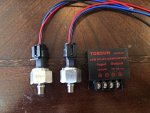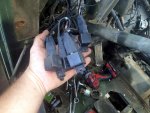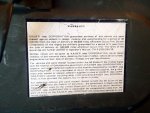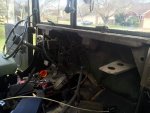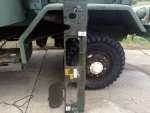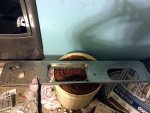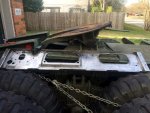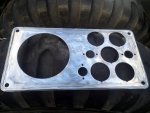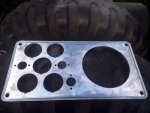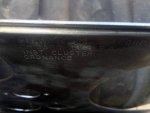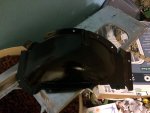mobileauto2000
Member
- 718
- 9
- 18
- Location
- Springfield Or
I like it.
Steel Soldiers now has a few new forums, read more about it at: New Munitions Forums!

I thought about that. I know it has the manual drive shaft brake also along with the air spring brakes on the rear.All you need is a 939 series truck to just rob all those parts off of and transplant to your truck. The 939s already have full air brakes and and air operated park brake.
Unless you have a good reason to add spring brakes or in your case, to replace the hand brake handle with a spring can, I would think twice about it. It's nice to be able to move the truck after you start it without having to wait for the air to build enough to release spring brakes.
I like making things difficult, lolAlso nice when the truck won't run, or is otherwise disabled. A lot less fuss without the air cans.
Yeah I was thinking that, might get with one of the surplus places that has them and see if they would want the old axles if I bought the disc ones from them.If you were to do the disc conversion I'd say just do an axle swap - all the parts already install on them.
High idle will only be for when vehicle is stationary, not moving. This is where the speed sensor comes in also. Same as on emergency vehicles, brake is pressed idle returns to normal.Sounds like an interesting project - I'd like to make a few safety recommendations:
1) High idle - you intend to have this directly control the speed of the engine, the same engine which you as a driver are responsible for controlling in traffic. For this "wet stacking prevention" feature, I'd advise that wet stacking is most likely to occur when you are idling for a long time, not in traffic. Place an electrical interlock on the parking brake, so that the solenoid cannot actuate the throttle once the brake is removed. For something as life-critical as this, I would actually say redundant interlock is the key (two switches, one one power supply, one on ground for the solenoid). A secondary interlock on the brake pedal would then be recommended (same dual switch concept) - as if the high idle were to accidentally trigger while you were driving, your default reaction would be to apply the service brakes. I mechanical interlock would also be a good idea - some thing which mechanically prevents the throttle from being altered in either of those two states (parking brake off, service brake on).
2) Your warning lights are there as your fail safe, you should not tolerate any failures in the air brake warning system - if you have a low-pressure warning that triggers at 85psi, a secondary system to do a non-electronic warning would be very important.
3) Your headlights and brake lights are the most important lights on your vehicle - you should have a backup system in place for your electronics. For example you could do the electromechanical equivalent of a watchdog timer, the Arduino would have to "prove" to the watchdog that it is functioning for the watchdog to allow the Arduino to control the lights, otherwise, fail back to old-school hardwired control.
Concerning emergency vehicles, taking it out of park or pressing the brake is still sending the signal to a software controlled device.Usually high idle on emergency vehicles is a switch and taking it out of park or stepping on the brake will disable it. There are cheap versions out there too for sure. I'm not thinking you're blazing new trail, I'm trying to look out for you in the liability department and maybe point out risks you may not have considered.
Sure you code and have been doing hardware design for years - however that P.O.S. Body Control Module (BCM) in your wife's car was made by people who went to school to do that for a living, and they couldn't get it right (but they are insured for such failures) - that's kind of what I'm trying to get at. The speed sensor you mention is still software-level control, the interlocks I'm talking about are hardware-level. What I'm trying to impress upon you is that no matter how good you think you are at coding or electronics design, you must always assume you made a mistake and think about how to mitigate that risk. If you're wrong, will you be thinking about the manual override at that very instant that the truck is lurching towards a mother with her infant twins in a stroller in a cross-walk? Would someone else driving your truck be trained for that contingency?
It's true fail-safe to have the entire high idle circuit physically cut when there is a condition that it should not be operated in - a manual override for such a circuit would be a switch that prevents power from actuating the solenoid (such as in the case of a software bug or a failure of the electronics due to other factors), a true mechanical override would be something which physically disconnects the solenoid shaft from the throttle (like in the case the solenoid becomes stuck, or a return spring breaks). I know the Arduino is cheap, but we're probably talking about a $2 switch on the parking brake, and a $2 switch on the service brake to be absolutely sure the Arduino doesn't take a spike and latch an IO in the wrong state or a rubbed wire short something and turn the solenoid on, or a metal shaving you missed when cleaning out an enclosure that hits that bump in the road and falls on the circuit board holding an IO pin high or low... (just another reason to conformal-coat the boards by the way)
Just think that if Toyota/Lexus had made it possible to shift from drive to neutral with the accelerator pedal pressed all the way to the floor and actually have it do something, or have a hard brake application (>50lbs) override the accelerator pedal input entirely, they probably wouldn't have killed that CHP officer and his family (which started all the trouble for them). Whatever you decide to build should be able to ingest conflicting information and control stimulus and act is the safest possible manner for the vehicle and the people around it. I would not encourage you to look at other enigneer's failures as a reason not to try to improve on their design.
FYI, the standard automotive spike test for 24VDC vehicles is 600V (this would be the worst-case alternator load-dump transient, not even EMP or ESD) - your power lines and IO lines on the Arduino would need to to be able to survive these constantly to be reliable from a hardware point of view, never mind the software reliability.
And yes, I don't yet trust all hardware engineers and probably never will (nature is rather efficient at producing new revisions of "idiot," no matter the pay scale), I like my vehicles: mechanical, manual, with a hardwired ignition switch... Of course you can do it your way, and you should by all means. As I say I'm just trying to look out for you.
